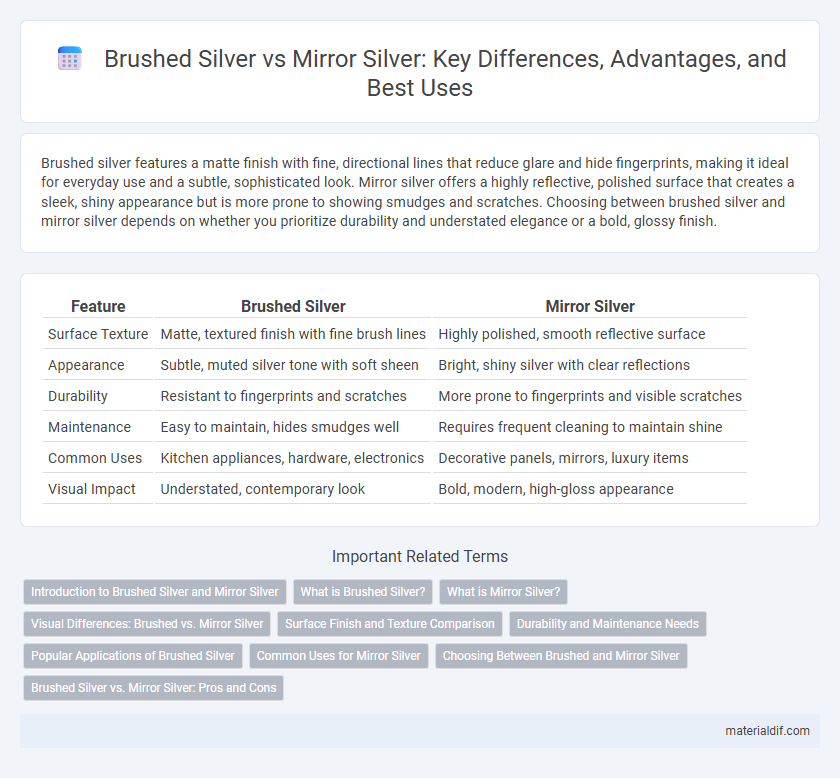Brushed silver features a matte finish with fine, directional lines that reduce glare and hide fingerprints, making it ideal for everyday use and a subtle, sophisticated look. Mirror silver offers a highly reflective, polished surface that creates a sleek, shiny appearance but is more prone to showing smudges and scratches. Choosing between brushed silver and mirror silver depends on whether you prioritize durability and understated elegance or a bold, glossy finish.
Table of Comparison
| Feature | Brushed Silver | Mirror Silver |
|---|---|---|
| Surface Texture | Matte, textured finish with fine brush lines | Highly polished, smooth reflective surface |
| Appearance | Subtle, muted silver tone with soft sheen | Bright, shiny silver with clear reflections |
| Durability | Resistant to fingerprints and scratches | More prone to fingerprints and visible scratches |
| Maintenance | Easy to maintain, hides smudges well | Requires frequent cleaning to maintain shine |
| Common Uses | Kitchen appliances, hardware, electronics | Decorative panels, mirrors, luxury items |
| Visual Impact | Understated, contemporary look | Bold, modern, high-gloss appearance |
Introduction to Brushed Silver and Mirror Silver
Brushed Silver features a textured finish achieved by polishing the metal surface with a fine abrasive, resulting in a matte, non-reflective appearance that reduces visible fingerprints and scratches. Mirror Silver, on the other hand, is polished to a highly reflective, glossy surface that produces a mirror-like shine ideal for decorative and luxury applications. Both finishes are popular in jewelry, electronics, and interior design, offering distinct aesthetic and functional qualities based on their surface treatment.
What is Brushed Silver?
Brushed silver is a metal finish characterized by fine, uniform scratches that create a matte texture, reducing reflectivity and hiding fingerprints or smudges effectively. This finish is achieved by polishing the silver surface with a fine abrasive tool in a consistent, linear motion, which enhances durability and adds a contemporary, understated appeal. Commonly used in household fixtures, jewelry, and electronics, brushed silver offers a sleek, modern alternative to highly reflective mirror silver.
What is Mirror Silver?
Mirror Silver is a highly polished, reflective finish that offers a smooth, glossy surface resembling a mirror's clarity and shine. Unlike Brushed Silver, which features a matte, textured appearance with fine lines or grain, Mirror Silver enhances light reflection and visual brightness. This finish is commonly used in decorative items, electronics, and jewelry to create a sleek, modern look.
Visual Differences: Brushed vs. Mirror Silver
Brushed Silver features a textured, matte finish with fine linear strokes that reduce glare and create a subtle, sophisticated appearance. Mirror Silver exhibits a highly reflective, smooth surface that produces sharp reflections and a polished, shiny look. Visual differences between these finishes impact design choices, with brushed silver offering understated elegance, while mirror silver provides a bold, striking aesthetic.
Surface Finish and Texture Comparison
Brushed silver features a matte finish with fine, unidirectional lines created by a brushing process that enhances texture and minimizes fingerprints, making it ideal for contemporary designs requiring subtle elegance. Mirror silver boasts a highly reflective, smooth surface achieved through polishing techniques that produce a glossy, mirror-like appearance, ideal for decorative applications emphasizing brightness and clarity. The choice between brushed and mirror silver hinges on desired aesthetic and practical considerations such as glare reduction versus high shine.
Durability and Maintenance Needs
Brushed silver features a textured, matte finish that effectively conceals scratches and fingerprints, making it more durable and easier to maintain over time compared to mirror silver. Mirror silver boasts a highly reflective, polished surface that requires frequent cleaning to prevent visible smudges and scratches, reducing its practicality for high-traffic areas. For long-lasting appearance with minimal upkeep, brushed silver is the preferred choice in applications where durability and low maintenance are critical.
Popular Applications of Brushed Silver
Brushed silver is widely used in interior design for appliances, furniture hardware, and decorative panels due to its matte finish that hides fingerprints and scratches effectively. Its subdued texture makes it popular in modern kitchens and bathrooms, providing a sophisticated yet durable surface. Compared to mirror silver, which is favored for reflective accents, brushed silver dominates in high-traffic areas requiring both aesthetic appeal and practical resilience.
Common Uses for Mirror Silver
Mirror Silver is commonly used in decorative applications, including high-end furniture finishes and automotive trim, due to its highly reflective surface that enhances aesthetic appeal. It is also favored for mirrors, jewelry, and electronic devices where clarity and shine are essential. Industrial applications like reflective coatings for solar panels and optical instruments utilize Mirror Silver for its superior reflectivity and durability.
Choosing Between Brushed and Mirror Silver
Brushed silver features a matte, textured surface that hides fingerprints and scratches, making it ideal for high-traffic areas or everyday use. Mirror silver offers a highly reflective, polished finish that enhances brightness and elegance but requires frequent cleaning to maintain its pristine appearance. Choosing between brushed and mirror silver depends on the desired balance between durability and aesthetic impact in your design or product.
Brushed Silver vs. Mirror Silver: Pros and Cons
Brushed silver offers a matte finish that resists fingerprints and hides scratches, making it ideal for high-traffic areas or daily use appliances. Mirror silver provides a highly reflective, polished surface that enhances aesthetic appeal but requires frequent cleaning to maintain its shine. Choosing between brushed and mirror silver depends on balancing durability and maintenance needs against desired visual impact.
Brushed Silver vs Mirror Silver Infographic

 materialdif.com
materialdif.com